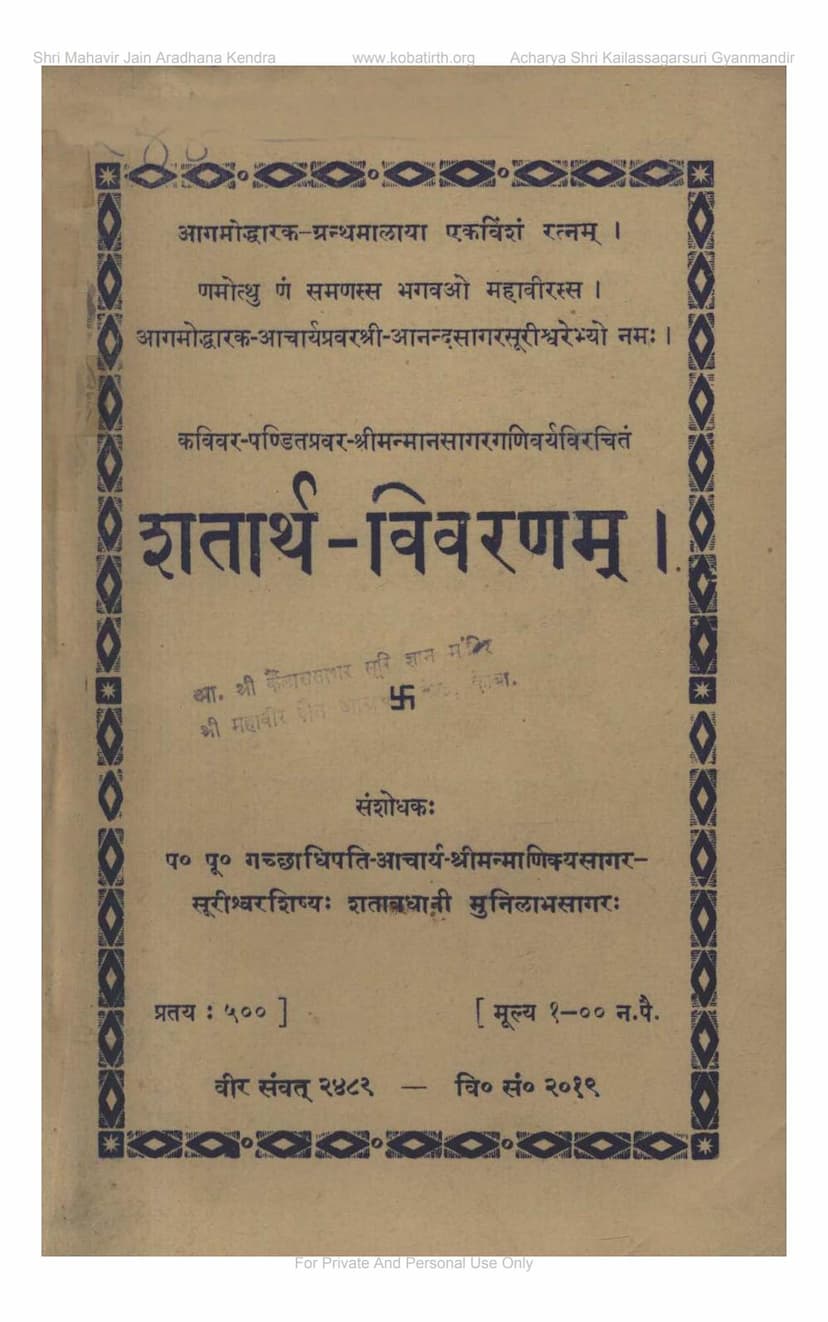Shatarth Vivaranam
Added to library: September 2, 2025

Summary
Here's a comprehensive summary of the Jain text "Shatarth Vivaranam" by Labhsagar, based on the provided pages:
Book Title: Shatarth Vivaranam (शतार्थ-विवरणम्) Author: Pandit Shriman Mansagar Ganivar (पण्डितप्रवर श्रीमन्मानसागरगणिवर्य) Editor/Compiler: Munishri Labhsagar (मुनिलाभसागर) Publisher: Agamoddharak Granthmala (आगमोद्धारक-ग्रन्थमाला) Edition: 21st Gem of Agamoddharak Granthamala Publication Year: Vir Samvat 2482 / Vikram Samvat 2019
Core Content and Purpose:
- "Shatarth Vivaranam" literally translates to "Explanation of a Hundred Meanings."
- The book is an extensive commentary on the single verse "Parigraharambhamagna star! Ye yu: katham paran. Swayam daridro na parmishwari kartumishvarah." (परिग्रहारम्भमग्नास्तारयेयुः कथं परान् । स्वयं दरिद्रो न परमीश्वरीकर्तुमीश्वरः ।।) from the Yogashastra (योगशास्त्र) by Acharya Hemchandracharya.
- The unique purpose of this work is to derive one hundred different meanings (शतार्थ) from this single verse, showcasing the depth and interpretative flexibility of Jain scriptures.
- The commentary systematically applies these hundred meanings to describe each of the 24 Tirthankaras (Jin), as well as other significant figures and concepts in Jainism.
Origin and Context:
- The book's creation is attributed to Pandit Shriman Mansagar Ganivar, a disciple of Pandit Shriman Buddhisagar Ganivar.
- It was composed during the reign of Emperor Akbar, under the guidance of Acharya Vijay Heersurishvarji, who is known for converting Akbar to Jainism.
- The direct impetus for this work was a challenge or examination posed by Acharya Vijay Heersurishvarji to Pandit Shriman Mansagar Ganivar, asking him to find 100 meanings for a specific verse in the Yogashastra. Pandit Mansagar successfully fulfilled this task.
Structure and Methodology:
- The commentary begins with a detailed explanation of the verse's words and their possible interpretations, drawing upon various Sanskrit and Prakrit lexicons and grammatical rules.
- The author meticulously breaks down the verse, dissecting syllables, word roots (dhatus), suffixes, and prefix interactions to generate multiple meanings.
- This process of deriving diverse meanings is then systematically applied to the description of each Tirthankara, starting from Rishabhnath and proceeding sequentially through all 24.
- Beyond the Tirthankaras, the commentary also extends to explain the verse in relation to:
- Twenty-four Jinas (Tirthankaras)
- Jinvani (Divine Speech)
- Shasanadevis (Guardian Deities)
- Panchaparameshtis (Five Supreme Beings: Arihant, Siddha, Acharya, Upadhyaya, Sadhu)
- Brahma, Vishnu, Maheshwar, Parvati, Lakshmi, Saraswati (Hindu deities, interpreted within a Jain philosophical framework)
- Navagraha (Nine celestial bodies)
- Digpalas (Eight directional guardians)
- Historical figures like Emperor Akbar
- Other significant concepts like knowledge, desire, and well-being.
Editorial and Publication Aspects:
- The book was compiled and edited by Munishri Labhsagar, who is noted as a "Shatavadhani" (possessing the ability to remember a hundred things simultaneously).
- The editing process involved carefully cross-referencing three different manuscripts: one from the Nitya-Vinaya Muni Jivan Library in Calcutta, another from the Jainal Anand Library in Surat, and a third provided by the scholar Muniraj Shri Punyavijayji Maharaj.
- The publisher, Agamoddharak Granthmala, aims to revive and disseminate ancient Jain scriptures. This book is noted as their 21st publication.
- Financial contributions for the publication are acknowledged from various individuals and institutions, reflecting the community support for such scholarly works.
Significance:
- Linguistic and Scholarly Prowess: The book is a testament to the author's deep understanding of Sanskrit grammar, etymology, and Jain philosophical terminology. It demonstrates a sophisticated method of scriptural exegesis.
- Depth of Jain Thought: By applying a single verse to a vast array of deities, Tirthankaras, and concepts, the book highlights the comprehensive and interconnected nature of Jain philosophy and practice.
- Preservation of Tradition: As part of the Agamoddharak Granthamala's mission, it contributes to the preservation and accessibility of valuable Jain literature.
- Exemplary Interpretation: It serves as an excellent example of how Jain Acharyas explored the multiple layers of meaning within sacred texts, often to inspire and educate the community.
In essence, "Shatarth Vivaranam" is a monumental work of interpretive scholarship within Jainism, showcasing the profound analytical skills of its author in deriving a hundred distinct meanings from a single verse and applying them to illuminate various aspects of the Jain tradition and beyond.